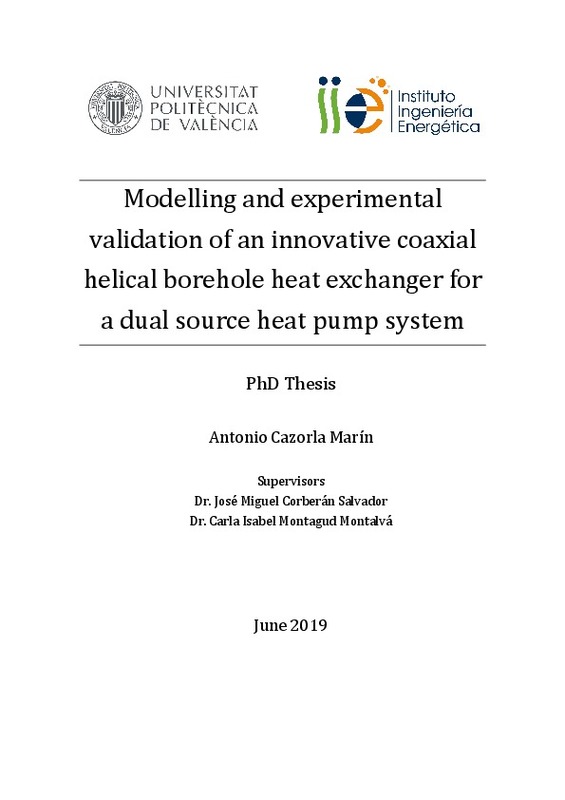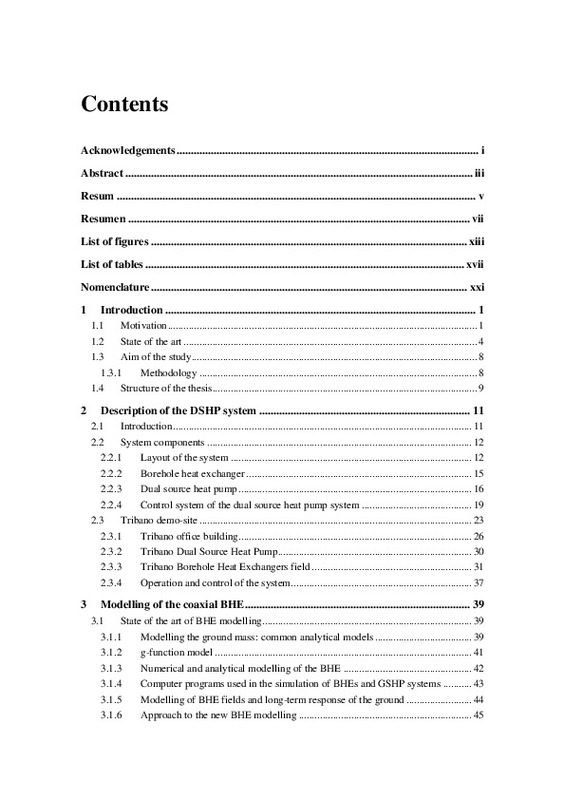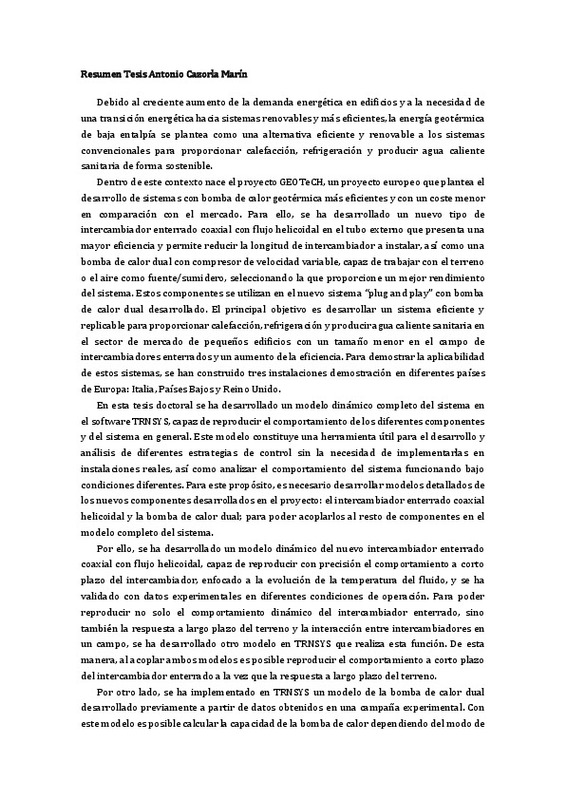|
Resumen:
|
[ES] La energía geotérmica de baja entalpía es una alternativa eficiente y renovable a los sistemas convencionales para proporcionar calefacción, refrigeración y producir agua caliente sanitaria (ACS) de forma sostenible.
El ...[+]
[ES] La energía geotérmica de baja entalpía es una alternativa eficiente y renovable a los sistemas convencionales para proporcionar calefacción, refrigeración y producir agua caliente sanitaria (ACS) de forma sostenible.
El proyecto GEOTeCH plantea el desarrollo de sistemas con bomba de calor geotérmica más eficientes y con un coste menor en comparación con el mercado. Para ello, se ha desarrollado un nuevo tipo de intercambiador enterrado coaxial con flujo helicoidal en el tubo externo que presenta una mayor eficiencia y permite reducir la longitud de intercambiador a instalar, así como una bomba de calor dual con compresor de velocidad variable, capaz de trabajar con el terreno o el aire como fuente/sumidero, seleccionando la que proporcione un mejor rendimiento del sistema. El principal objetivo es desarrollar un sistema eficiente y replicable para proporcionar calefacción, refrigeración y producir ACS en el sector de mercado de pequeños edificios con un tamaño menor en el campo de intercambiadores enterrados y un aumento de la eficiencia. Para demostrar la aplicabilidad de estos sistemas, se han construido tres instalaciones demostración en tres países europeos.
En esta tesis doctoral se ha desarrollado un modelo dinámico completo del sistema en el software TRNSYS, capaz de reproducir el comportamiento de los diferentes componentes y del sistema en general. Este modelo constituye una herramienta útil para el desarrollo y análisis de diferentes estrategias de control sin la necesidad de implementarlas en instalaciones reales, así como analizar el comportamiento del sistema funcionando bajo condiciones diferentes. Para este propósito, es necesario desarrollar modelos detallados de los nuevos componentes desarrollados en el proyecto: el intercambiador enterrado coaxial helicoidal y la bomba de calor dual; para poder acoplarlos al resto de componentes en el modelo completo del sistema.
Por ello, se ha desarrollado un modelo dinámico del nuevo intercambiador, capaz de reproducir con precisión el comportamiento a corto plazo del intercambiador, enfocado a la evolución de la temperatura del fluido, y se ha validado con datos experimentales en diferentes condiciones de operación. Para poder reproducir no solo el comportamiento dinámico del intercambiador enterrado, sino también la respuesta a largo plazo del terreno y la interacción entre intercambiadores en un campo, se ha desarrollado otro modelo en TRNSYS que realiza esta función. De esta manera, al acoplar ambos modelos es posible reproducir el comportamiento a corto plazo del intercambiador enterrado a la vez que la respuesta a largo plazo del terreno.
Por otro lado, se ha implementado en TRNSYS un modelo de la bomba de calor dual desarrollado. Con este modelo es posible calcular la capacidad de la bomba de calor dependiendo del modo de operación en que esté funcionando, de la frecuencia del compresor y otras variables y condiciones de operación.
El modelo del sistema dual en TRNSYS se ha utilizado para hacer un análisis de su comportamiento funcionando en diferentes climas, para ello se han seleccionado tres ciudades en España y en Europa con diferentes climas y se han realizado simulaciones del sistema funcionando en cada ciudad.
Por otro lado, también se ha modelado en TRNSYS una de las instalaciones demostración del proyecto GEOTeCH, incluyendo el edificio climatizado y el acoplamiento con los fan coils. Con este modelo se estudia una nueva estrategia para controlar la frecuencia del compresor en base a la temperatura de las habitaciones, en lugar de controlarla en base a la temperatura de suministro, con el objetivo de reducir el consumo del compresor cuando ya se haya conseguido el confort. Además, otras estrategias de optimización se han analizado con el modelo.Por tanto, los modelos desarrollados constituyen herramientas útiles para ayudar en el diseño del sistema y los diferentes componentes, el análisis de su comportamiento y el d
[-]
[CA] L'energia geotèrmica de baixa entalpia es planteja com una alternativa eficient i renovable als sistemes convencionals per proporcionar calefacció, refrigeració i produir aigua calenta sanitària (ACS) de forma ...[+]
[CA] L'energia geotèrmica de baixa entalpia es planteja com una alternativa eficient i renovable als sistemes convencionals per proporcionar calefacció, refrigeració i produir aigua calenta sanitària (ACS) de forma sostenible.
El projecte GEOTeCH planteja el desenvolupament de sistemes amb bomba de calor geotèrmica més eficients i amb un cost menor en comparació amb el mercat. Per a això, s'ha desenvolupat un nou tipus d'intercanviador enterrat coaxial amb flux helicoïdal en el tub extern que presenta una major eficiència i permet reduir la longitud a instal·lar, així com una bomba de calor dual amb compressor de velocitat variable, capaç de treballar amb el terreny o l'aire com a font, seleccionant la que proporcione un millor rendiment. Aquests components s'utilitzen en el nou sistema amb bomba de calor dual. El principal objectiu és desenvolupar un sistema eficient i replicable per proporcionar calefacció, refrigeració i produir ACS en edificis xicotets amb una grandària menor d'intercanviadors soterrats i un augment de l'eficiència. Per demostrar l'aplicabilitat d'aquests sistemes, s'han construït tres instal·lacions demostració en Itàlia, Països Baixos i Regne Unit.
En aquesta tesi s'ha desenvolupat un model dinàmic complet del sistema en TRNSYS, capaç de reproduir el comportament dels components i del sistema en general. Aquest model constitueix una eina útil per al desenvolupament i anàlisi de diferents estratègies de control sense la necessitat d'implementar-les en instal·lacions reals, així com analitzar el comportament del sistema funcionant en condicions diferents. Per a això, cal desenvolupar models detallats dels nous components desenvolupats en el projecte: l'intercanviador enterrat i la bomba de calor dual; per poder acoblar-los a la resta de components.
Per això, s'ha desenvolupat un model dinàmic del nou intercanviador enterrat, capaç de reproduir amb precisió el comportament a curt termini de l'intercanviador, enfocat a l'evolució de la temperatura del fluid, i s'ha validat amb dades experimentals en diferents condicions d'operació. Per a poder reproduir no només el comportament dinàmic de l'intercanviador soterrat, sinó també la resposta a llarg termini del terreny i la interacció entre intercanviadors en un camp, s'ha desenvolupat un altre model en TRNSYS que realitza aquesta funció. D'aquesta manera, en acoblar els dos models és possible reproduir el comportament a curt termini de l'intercanviador enterrat, al mateix temps que la resposta a llarg termini del terreny.
D'altra banda, s'ha implementat en TRNSYS un model de la bomba de calor. Amb aquest model és possible calcular la capacitat de la bomba de calor depenent del mode d'operació en què estiga funcionant, de la freqüència del compressor i altres variables i condicions d'operació.
El model del sistema dual en TRNSYS s'ha utilitzat per a fer una anàlisi del seu comportament funcionant en diferents climes, per a això s'han seleccionat tres ciutats a Espanya i tres a Europa amb diferents climes i s'han realitzat simulacions del sistema funcionant en cada ciutat durant un any. S'ha analitzat l'eficiència del sistema en cada ciutat, així com l'ús de cadascuna de les fonts (aire / terreny).
D'altra banda, també s'ha modelat en TRNSYS una de les instal·lacions demostració del projecte GEOTeCH, incloent l'edifici d'oficines climatitzat i l'acoblament amb els fan coils. Amb aquest model es pretén estudiar una nova estratègia per a controlar la freqüència del compressor d'acord amb la temperatura de les habitacions, en lloc de controlar-la en base a la temperatura de subministrament, amb l'objectiu de reduir el consum del compressor quan les habitacions ja es troben en condicions de confort. A més, altres estratègies d'optimització s'han analitzat amb el model.
Per tant, els models desenvolupats constitueixen eines útils per ajudar en el disseny del sistema i els diferents components, l'anàlisi del
[-]
[EN] Low enthalpy geothermal energy is considered as an efficient and renewable alternative to conventional systems to provide heating, cooling and Domestic Hot Water (DHW) production in a sustainable way.
In this context, ...[+]
[EN] Low enthalpy geothermal energy is considered as an efficient and renewable alternative to conventional systems to provide heating, cooling and Domestic Hot Water (DHW) production in a sustainable way.
In this context, the GEOTeCH project proposes the development of more efficient geothermal heat pump systems with a lower cost compared to the market. To this end, a new type of coaxial Borehole Heat Exchanger (BHE) with helical flow through the outer tube has been developed, which presents a higher efficiency and allows to reduce the length of the heat exchanger to be installed, as well as a Dual Source Heat Pump (DSHP) with variable speed compressor, capable of working with the ground or air as a source / sink, selecting the one that provides the best performance of the system. These components are used in the new DSHP system developed. The main objective is to develop efficient and replicable systems to provide heating, cooling and DHW in the market sector of small buildings with a smaller size of the BHE field and an increase in the efficiency. To demonstrate the applicability of these systems, three demonstration facilities have been installed in Italy, the Netherlands and the UK.
In this thesis, a complete dynamic model of the system has been developed in the TRNSYS software, capable of reproducing the behavior of the different components and the system in general. This model is a useful tool for the development and analysis of different control strategies without the need to implement them in real installations, as well as analyses the behavior of the system operating under different conditions. For this purpose, it is necessary to develop detailed models of the new components developed in the project: the BHE and the DSHP; to couple them to the rest of the components of the system.
For this reason, a dynamic model of the new BHE was developed, able to accurately reproduce its short-term behavior, focused on the evolution of the fluid temperature, and validated with experimental data in different operating conditions. In order to reproduce not only the dynamic behavior of the BHE, but also the long-term response of the ground and the interaction between BHEs in a field, another model was developed in TRNSYS. In this way, by coupling both models, it is possible to reproduce the short-term behavior of the BHE as well as the long-term response of the ground.
On the other hand, a model of the DSHP was implemented in TRNSYS. With this model, it is possible to calculate the capacity of the heat pump depending on the operating mode in which it is operating, the frequency of the compressor and other variables and operating conditions.
The model of the hybrid system in TRNSYS has been used to make an analysis of its behavior working in different climatic conditions, for which three cities have been selected in Spain and three in Europe, with different climates. So, different simulations of the system have been carried out in each city for one year. The efficiency of the system in each city has been analyzed, as well as the use of each of the sources (air / ground).
On the other hand, one of the demo-sites of the GEOTeCH project, including the conditioned office building and the coupling with the fan coils, has also been modelled in TRNSYS. With this model, it is studied a new strategy to control the frequency of the compressor based on the temperature of the rooms, instead of controlling it based on the supply temperature, with the aim of reducing the consumption of the compressor when the rooms are already in comfort conditions. In addition, other optimization strategies have been analyzed with the model.
Therefore, the models developed, both for the BHE and the system, are able to reproduce their operation and can be used as virtual installations, constituting useful tools to help in the design of the system and the different components, the analysis of their behavior and the development of optimization strategies.
[-]
|











